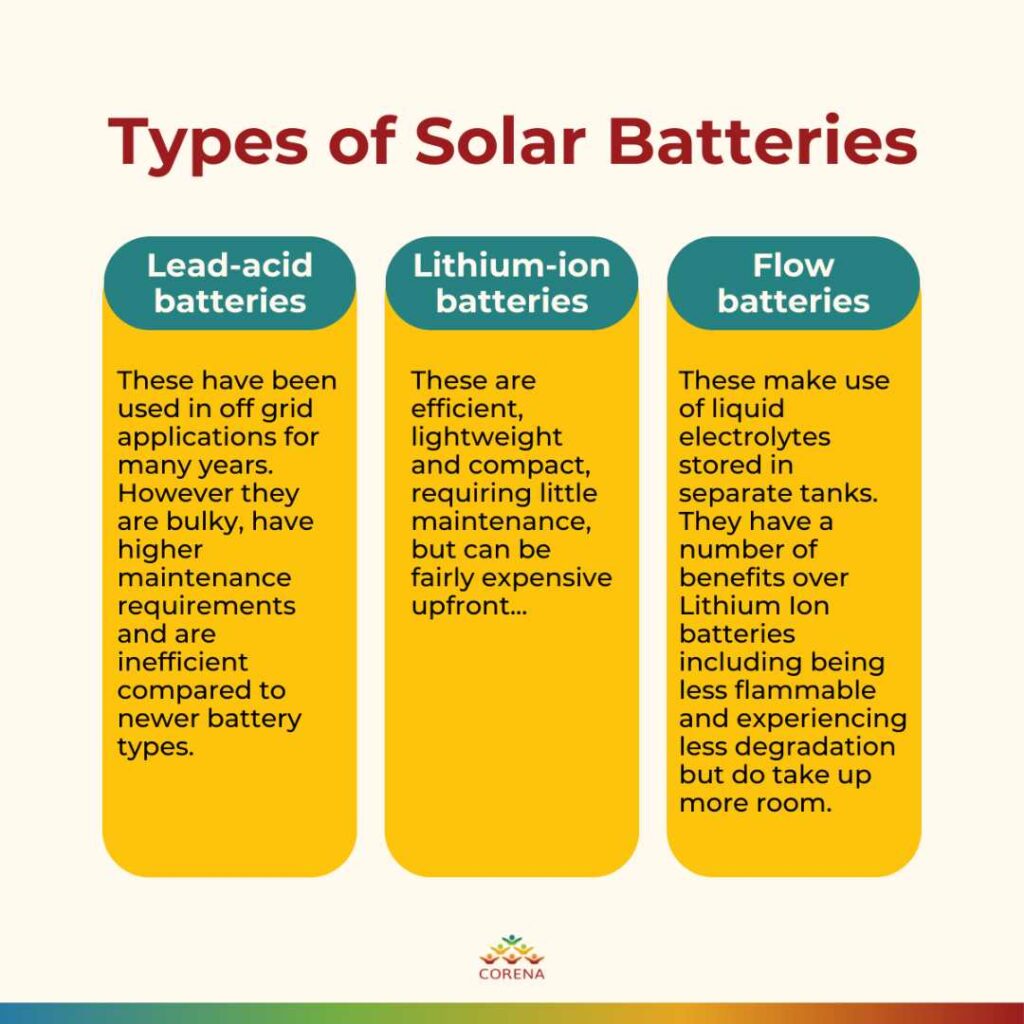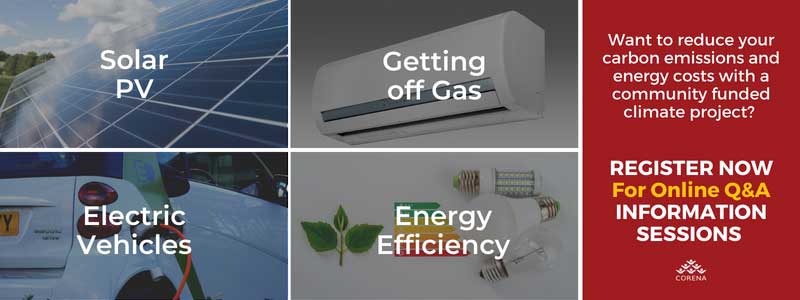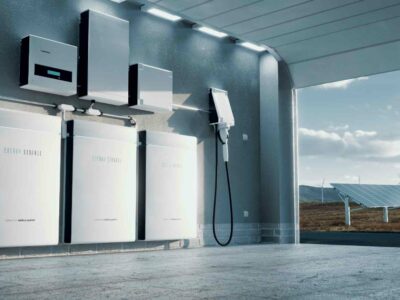Updated: 9/5/2025
Solar batteries store the excess energy that solar panels produce so that it can be used when the sun isn’t shining, be it at night or during inclement weather. If you already have a solar power system, or your organisation is considering investing in one, a solar battery as part of the installation may increase your savings, allow for backup in a grid outage and, more broadly, support the grid to adopt more renewables.
CORENA works with a wide range of non profits, providing technical advice and interest free loans to fund solar panels, energy efficiency and other initiatives in order to help organisations reduce carbon emissions and save on their energy costs.
CORENA initially didn’t often loan to battery projects as it was usually difficult for them to pay for themselves. However, as power prices increase we will now model the returns for a battery for our potential loan recipients and they are becoming increasingly viable for many not for profit organisations particularly those with evening operating hours and “time of use” or “demand” tariffs when the returns are combined with their solar systems. Some examples include our projects with Capri Theatre, the Northern Agricultural Catchments Council, City of Sydney Basketball and Youth Options. They use a significant amount of their electricity in the evening, have the ability to install excess solar to charge the battery and are able to cycle the battery often, therefore using it to its full capacity. Their particular electricity tariff may also allow them to save money with a battery as it allows them to avoid purchasing power during high demand times (peak periods) when electricity is most expensive.
CORENA also considers the level of carbon emission reductions from projects. Batteries don’t reduce carbon emissions on their own. However, with the increasing uptake of renewables in many states, batteries now allow for abundant solar electricity to be “soaked up” in the middle of the day, reducing the use of power from the grid in evening peak times, playing a part in allowing for greater uptake of renewable energy and decarbonising the grid as a whole.
This can occur at the building scale or at a larger “community battery” scale like our projects with Hepburn Energy and Goulburn Community Solar Farm.
With many of our projects now including battery technology, we’ve put together this guide about the different kinds of solar batteries available and why, when and how to use them effectively.
Types of Solar Batteries
There are various types of solar batteries available on the market, each with its own advantages and disadvantages. Choosing the right kind of solar battery for your project depends on the requirements of your particular system as well as the specific needs and budget that you have available.

Battery chemistries are rapidly evolving, becoming safer and more efficient all the time. There are various other types of batteries available, including saltwater batteries, hybrid batteries that combine different technologies in one; nickel-ion batteries; and sodium-ion batteries.
However, currently, lithium-ion batteries are preferred for most smaller-scale installations thanks to their high energy density, long lifecycle, and ease of maintenance—ideal for the average user.
Why Use Solar Batteries?
One of the benefits of using solar batteries is that they help you make the most of the energy that is generated through your solar panels. Solar panels alone are only effective when there is sufficient sunshine to provide power. Batteries, however, can help you maximise that electricity use by storing it rather than wasting it.
Batteries can help you reduce your ongoing power bills even further than just solar panels on their own. They are also very important in allowing for more renewable energy to be added to the grid.
Another advantage is they can provide a level of backup power in blackouts. However not all batteries do and some may only provide power to certain appliances (eg your lighting or power outlets) but may not run your entire building. If this is a feature you wish to have you need to discuss this carefully with your installer to make sure you get what you need.
When Should Solar Batteries Be Used?
A battery could be beneficial to your organisation if:
- You generate significant excess solar power with your existing system or, if you are installing a new system, your roof space allows you to install a solar system that is big enough to generate excess solar. You need to generate enough excess solar to charge your battery sufficiently every day. If this is not an option your installer may also be able to program your battery to charge from the grid during periods of cheap power.
- You use a lot of power in the evenings. Offices, for example, typically don’t use a lot of power at these times.
- You are already, or have the ability to shift to, a time of use tariff or demand tariff. A time of use tariff charges you different amounts for using power at different times of the day. So for example you may get charged 30c/kWH for using power from 9am-3pm but 50c/kWh from 3pm-9pm and only 15c/kWH overnight. This means that the battery would allow you to avoid using power in the expensive period while still accessing cheap power at other times of the day. Some organisations may also be on a demand tariff. Demand tariffs usually consist of a demand charge based on your maximum electricity demand at times when the grid is experiencing very high use. They have been designed to encourage less electricity use during these peak demand times. A battery is able to help you reduce your peak demand and therefore can save you a lot of money on these tariffs. Shifting to one of these tariffs can, if you are not careful, increase your bill so it is important to look at your existing energy use and work out if it is better to switch. For small organisations looking at a time of use tariff, CORENA may be able to help you do this. Larger organisations with a demand tariff may need the assistance of an energy consultant to do this sophisticated analysis.
- You can participate in a Virtual Power Plant (VPP). Your battery has the potential to unlock even more cost savings if you participate in a virtual power plant. A VPP can aggregate the capacity of your solar and batteries and sell the power and grid services your solar and batteries provide. A Virtual Power Plant may charge or draw on the power in your battery at certain times, reduce export of your solar or even switch it off all together in certain situations. You are then paid for providing these services. While many people don’t like the idea of giving up some control of their battery it is actually quite a powerful way to allow more renewable energy into the grid and maintain grid stability. However make sure you read the terms and conditions carefully, some VPPs are better deals than others. It is also important to check that they will leave you a reserve battery capacity (ie never draw down your battery beyond a certain level) so there is energy left for you when you need it!
Learn more in Virtual Power Plants: Sharing Renewable Energy Resources
How To Use Solar Batteries Effectively
The first thing you need to do before installing a solar battery system is take inventory of your organisation’s daily electricity consumption. This will help you determine what size battery system you need. By completing an energy audit you may find that there are other more cost effective things you could do to reduce your energy use first or shift your evening energy use to the middle of the day. That way you are not spending extra installing an unnecessarily large battery.
Learn more in Energy Efficiency Audit Guide For Non Profits
If you already have a solar system have a look at your monitoring data to see if you are exporting excess solar. If your solar is mostly consumed by your operations there may not be enough excess to charge a battery every day. If this is the case you could expand your solar system or potentially even set up a battery to charge from the grid using cheap daytime power if you have access to a time of use or demand tariff.
As you can see, the best option for your organisation will depend on your energy use profile, your current tariff (or the available tariffs you could change to), and your current solar (if applicable). Before you get a quote you can model some scenarios to see which gives you the best returns. If you are handy with a spreadsheet you could use Renew’s Sunulator or alternatively Sunspot or Solar Quote’s Solar & Battery Calculator.
These tools have the option to use your interval data (also called NEM 12 data). This data is available if you have a smart meter and you should be able to request it from your energy retailer or download it from your online account portal. This data allows you to get a much more accurate battery sizing to cover your evening and/or night time use as it uses your actual consumption data rather than using assumptions, estimates and averages.
To size a battery to be completely off grid it would need to be very large so it has enough electricity to power all of your needs in the rare situations when there may be 3-4 days of bad weather. This is usually cost prohibitive unless you are constructing a new building and the cost to upgrade your power supply or bring power to the site is going to be very high. In this case an off grid battery might be cheaper.
Most people are installing batteries to maximise their cost savings so the installer will size the battery to either cover the expensive evening peak period (and use a cheap overnight power rate for the rest of the night) or meet most of their daily electricity needs. For the times when there is ongoing bad weather, or particularly high consumption, they draw from the grid. This means they only need a smaller battery which costs less upfront but are still seeing the majority of savings.
Sizing the battery is a balancing act between these things and the installer should use a model to work out what is best for you. CORENA can double check their battery sizing to make sure it seems reasonable.
The next step is to choose a good Solar Accreditation Australia Clean Energy Council Accredited Installer to size your battery for you and provide a quote.
Learn more in How To Find A Certified Solar Panels Installer & Get A Good Quote
Monitoring Solar Batteries
Most modern battery systems come with customer-facing applications that allow you to see your energy usage in real time so that you can properly manage your consumption and match it with the solar generation capacity. This is not just useful for monitoring the performance of your battery but also managing your overall energy use over the longer term.
Learn more in How Energy Monitoring Can Reduce Carbon Emissions & Electricity Costs For Non Profits
Being Solar Battery Ready
Many not for profits who are installing solar may not want to install a battery at this time but ask about making it “Battery ready” or “Battery compatible”. Most solar systems should be able to be retrofitted with a battery in a few different ways. To understand how, it’s useful to understand how a battery system works and a couple of terms used by installers.
In a typical solar system the solar panels make DC (direct current) electricity. The inverter transforms the DC electricity to AC (alternating current) electricity which is able to be used by appliances.
Your battery is charged by DC electricity so there are a couple of ways it can be made to work with your existing panels.
- Using a battery inverter (AC coupled battery) – this takes the AC electricity from the solar inverter transforms the electricity back to DC to charge the battery and then back to AC again to power your appliances. Each time this happens a little bit is lost to efficiency losses but it isn’t likely to be material to your power bill.
- Replace the existing inverter – your existing inverter can be removed and replaced with a new hybrid inverter (also called DC coupled). This type of inverter can charge the battery with DC electricity AND convert the electricity to AC for use in your house. This type of inverter has a number of advantages including potentially allowing you to have a larger solar system than an AC coupled system and allowing more power outage backup options but is usually more expensive.
If you are buying a solar panel system and want it to be battery compatible in the future some installers may interpret this as you saying you want a hybrid inverter. These hybrid inverters are often all wired up ready to plug in a battery if you purchase one down the track. However hybrid inverters are more expensive and may only be compatible with certain battery brands and with technology and standards evolving so quickly there is no guarantee that a particular battery will be the best option when you go to install it. This Solarquotes article provides an excellent analysis of the pros and cons of hybrid or “normal” solar inverters. Another option CORENA has seen installers quote is a cheaper (but still good quality) inverter which provides more flexibility if a battery needs to be added down the track as it could either be used with a battery inverter or just replaced with a hybrid inverter at the time.
Weighing up these options and choosing the best option for you depends on the actual costs quoted by your solar installer/s. Going back to the calculators discussed earlier in this article and reviewing your options again with the actual costs can be really helpful in working out what is best for you. If your not for profit needs assistance with this, contact CORENA to find out how we can help.
Using a Solar Battery as Backup in Power Outages
Having access to power in an emergency is an enormous benefit in, and after, a disaster. It allows people to charge their phones, run refrigeration, retain internet access and keep payment systems online so people can purchase goods and services without cash (provided the internet in your area is not also down!).
Islandable means that your solar and battery system is able to work in a power outage. Many people don’t realise that not all solar and battery systems work in a blackout. If you are purchasing solar panels and battery system it is important to specify what you need the system to do in a blackout and ensure your installer is able to deliver this.
It is also very expensive to purchase a battery that will power an entire building in a blackout. You will need to choose what you need backed up in an emergency. This might be a fridge, lights and power points to charge phones, computers and an internet router.
For community centres who are acting as evacuation centres or communication hubs in a disaster an islandable solar and battery system that is able to recharge itself with its solar would be an incredibly valuable resource allowing people to maintain connection with the outside world.
Learn more in How Australians Can Improve Disaster Preparedness & Resilience
Battery Recycling
Lithium-ion batteries contain many valuable critical materials making them desirable to recycle and 95 per cent of battery components can be recovered for recycling. There are a number of start-ups that have gained government funding in Australia to recycle batteries. While referring to EV batteries this great article by Drive outlines the current state of play in the battery recycling industry.
Renewable Energy Battery Developments in Australia
Australia is rapidly embracing renewable energy, and the development and deployment of battery storage are crucial for this transition. Several factors are driving this growth, including government incentives, election promises, and state-level initiatives.
Incentives:
Many state governments in Australia offer various incentives to encourage the uptake of renewable energy batteries for households and businesses.
- Federal Initiatives: The Cheaper Home Batteries Program, a significant $2.3 billion initiative is slated to begin on July 1, 2025. This program aims to reduce the upfront cost of home battery installations by 30% through a rebate, potentially saving households up to $4,000 on a typical system. The rebate will be administered through the existing Small-scale Renewable Energy Scheme (SRES). The program also extends to small businesses and community facilities, subsidising batteries up to 50 kWh in capacity (within a total system size of 100 kWh). Batteries must be “Virtual Power Plant (VPP) ready,” although participation in a VPP is not mandatory to receive the rebate. Systems ordered and installed between April 6, 2025, and July 1, 2025, would be eligible, provided they are not switched on before July 1, 2025. This federal rebate can be combined with existing state government schemes. We don’t know all the details yet but will update this blog when we do!
- State Initiatives: Various states and territories have their own battery rebate and loan programs:
- New South Wales: Offers an upfront discount on battery installation costs, with the discount amount related to the battery’s usable capacity. There are also incentives for connecting existing batteries to Virtual Power Plants (VPPs).
- Victoria: Provides interest-free loans for eligible households to install solar batteries, up to $8,800. Concession card holders may also qualify for additional rebates.
- Queensland: Has a Queensland Battery Industry Strategy with a $570 million investment over five years to support innovation, commercialization, and supply chain growth in the battery industry. This includes grants and support for establishing an Australian-Made Battery Precinct.
- Western Australia: Will offer rebates for home batteries, with higher rebates for Horizon Power customers as at the 1st of July 2025. Zero-interest loans will also beavailable for eligible households.
- South Australia: Has previously offered a grid-scale storage fund to support large battery projects.
- Tasmania: Supports businesses involved in battery-powered electric ferries and mining equipment.
- Northern Territory: Provides generous grants for home and business battery systems, up to $400 per kWh of usable capacity, with a maximum grant of $12,000.
- Australian Capital Territory (ACT): Offers zero-interest loans for home battery storage and solar + storage systems under its Sustainable Household Scheme.
Beyond direct financial incentives, state governments are also undertaking broader initiatives to support renewable energy battery development and integration:
- Renewable Energy Zones (REZ): States like New South Wales are establishing Renewable Energy Zones to concentrate renewable energy generation and storage projects, enhancing efficiency and reducing environmental impact.
- Grid-Scale Battery Projects: Various states are investing in large-scale battery storage projects to improve grid stability and support the integration of variable renewable energy sources. Examples include the Collie Battery Energy Storage System in Western Australia and battery projects in South Australia and Victoria.
- Virtual Power Plants (VPPs): Several state initiatives encourage the connection of household batteries to VPPs, allowing homeowners to earn additional income by exporting excess stored energy to the grid and contributing to grid stability.
- Manufacturing & Research Support: States like Queensland, Victoria, and New South Wales are investing in research, development, and manufacturing capabilities within the battery industry to establish Australia as a key player in the global battery supply chain.
These combined efforts from federal and state governments, along with specific election promises, indicate a strong commitment to fostering the growth of renewable energy battery storage in Australia. This will be crucial for achieving renewable energy targets, enhancing grid reliability, and reducing energy costs for consumers.
Learn more in Australia’s Renewable Energy Revolution
Solar Panels & Renewable Energy Battery Funding for Non Profits
Apart from applying for grants and rebates, here at CORENA, we can provide free technical advice and zero interest funding to community organisations looking to reduce their emissions and green their energy consumption. We encourage loan recipients to combine their loan with local rebates and grants where possible. We are funded by donations from local community members across Australia. Donations help us fund:
- Solar Panels and Batteries
- Energy Efficiency
- Getting Off Gas – Replacement of fossil gas appliances with electric alternatives
- Electric Vehicles
- A combination of the above
Learn more in 5 Ways CORENA Helps Non Profits Reduce Carbon Emissions & Energy Costs
You don’t pay any interest on your CORENA loan, and the quarterly loan repayments are set to be a little less than the savings on your operating costs averaged over a year. This means you are never out of pocket. After your loan is fully repaid, you will reap the full financial benefit of having lower operating costs.
To learn more, check out how to apply for a loan, or register for one of our upcoming Online Q&A Information Sessions.


